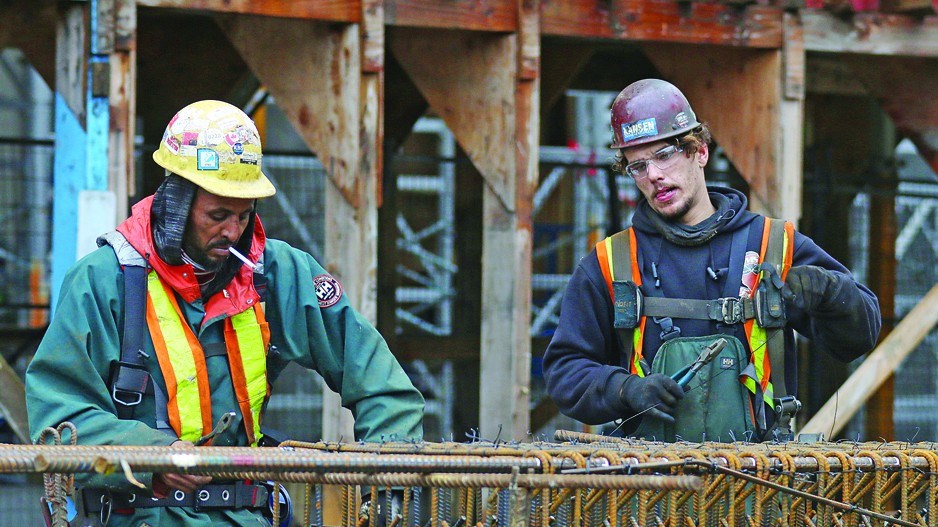West Coast job growth tapped the brakes ever so slightly in October, adding 9,800 jobs to the economy compared with 32,900 a month earlier.
The unemployment rate dropped 0.1 percentage point to land at 4.2 percent — the lowest rate in the country after Quebec (4.1 per cent), according to Statistics Canada data released Friday (Nov. 4).
The last two months of gains reverses losses in August (-28,100 jobs) that teased perhaps some relief was on the way for labour markets facing an increasingly tight squeeze to meet job demand.
Jobs in construction (+6,000 jobs), manufacturing (+11,500 jobs) and the information, culture and recreation bucket that’s typically associated with the film and TV sector (+6,900 jobs) delivered the biggest gains for B.C.
Positions associated with finance and real estate (-7,100 jobs) and education (-7,100 jobs) suffered the biggest losses along with accommodation and food services (-5,600 jobs).
Meanwhile, the rest of the country also kept pace with B.C.’s gains to the tune of 108,000 jobs last month while the national unemployment rate remained unchanged at 5.2 per cent as more people entered the workforce looking for jobs.
Every single province saw job gains in October, a rare occurrence.
“Early signs of softening in the labour market were part of the reason the Bank of Canada opted for a smaller – but still large – 50 basis point hike to the overnight interest rate in October, signalling that the current rate hiking cycle could be in its late stages,” RBC assistant chief economist Nathan Janzen said in a note.
“Inflation data will remain the main driver of the BoC's interest rate decisions, but the rebound in labour markets in October will also add pressure to push interest rates higher.”
TD economist Rishi Sondhi said the national numbers blew away expectations as losses over the past few months were more than recouped.
“Wow. This jobs report checked all the boxes in terms of being a blowout report. Headline job growth surged, and gains were powered by full-time, private sector positions,” he said in a note.
“The Canadian labour market clearly still has some steam left to it.”
These big gains come the same week Immigration Minister Sean Fraser announced Ottawa would be upping its targets for immigration with the goal of bringing in 500,000 newcomers annually by 2025 in a bid to stimulate the economy.
But it may not be enough to keep up with demand on the West Coast, according to Ken Peacock, chief economist of the Business Council of B.C.
“Even ramping up immigrants very dramatically as the federal government has done is probably not going to provide enough immigrant workers to fill these openings,” he told BIV last month, referring to when Ottawa previously upped its targets in February.
“It would be foolish to say it doesn’t help. Just looking at the numbers, it’s very clear they’ve ramped up significantly. But very quickly … you get into skill-matching. Which roles are open? Are these immigrants qualified? Etc., etc. Many of them may be, but the likelihood of skills matching directly and people rolling right into the job market is probably a little more nuanced.”
Despite those challenges, the BCBC estimates there is currently an 80 per cent participation rate in the province’s labour market among newcomers who’ve arrived within the last five years.
That’s notably higher than historical levels.
B.C. Jobs Minister Ravi Kahlon believes the new immigration targets mean about 8,000-10,000 newcomers reaching the province annually.
“We can handle that in British Columbia, but we're going to need those additional supports,” he told BIV, referring to premier-designate David Eby’s plans to boost housing supply.
Meanwhile, Kahlon said he’s hopeful lower childcare costs will also help bring more women into the labour force to meet market demand.
Last year the province and the feds cut a deal to create an average of $10-a-day childcare for all regulated spaces for children under the age of six. B.C. will receive $3.2 billion over five years, while the province itself pledged to put $2.5 billion towards early learning and childcare over three years.
The province announced in September it would reduce childcare fees up to $220 to $550 depending on the age and number of children within a family beginning Dec. 1.
“I certainly hope that means more women entering the labour market,” Kahlon told BIV. “We still hear from employers of labour shortages, we’re still hearing from employers that they're having challenges to meet that demand and some of that demand is going to come from women.”
He added he was particularly pleased with last month’s jobs data amid an economic environment that has seen the Bank of Canada hike its key rate by 350 basis points since the start of the year. The central bank’s intent is to put a lid on access to cheap capital in a bid to cool the economy and tamp down on inflation.
“The big rebound in employment during October, accompanied by a rebound in the size of the labour force, is likely a sign that the declines seen over the summer were largely statistical noise, rather than a sign that the labour market truly surged ahead this month,” CIBC senior economist Andrew Grantham said in a note.
“Still, today's data support our call for a 50bp hike at the December [Bank of Canada] meeting, rather than a more standard 25bp move, although there are plenty of economic data releases still between now and then, including one more labour force survey.”




